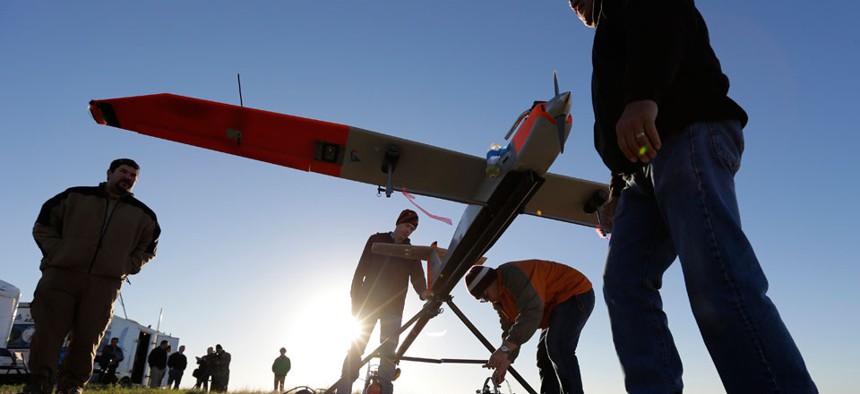Analysis: Drones Herald the End of the Age of the Gun

Texas A&M Corpus Christi researchers prepare a unmanned aircraft system for testing at a ranch near Sarita, Texas. Eric Gay/AP
Drones will cause an upheaval of society like we haven’t seen in 700 years.
The human race is on the brink of momentous and dire change. It is a change that potentially smashes our institutions and warps our society beyond recognition. It is also a change to which almost no one is paying attention. I’m talking about the coming obsolescence of the gun-wielding human infantryman as a weapon of war. Or to put it another way: the end of the Age of the Gun.
You may not even realize you have been, indeed, living in the Age of the Gun because it’s been centuries since that age began. But imagine yourself back in 1400. In that century (and the 10 centuries before it), the battlefield was ruled not by the infantryman, but by the horse archer—a warrior-nobleman who had spent his whole life training in the ways of war. Imagine that guy’s surprise when he was shot off his horse by a poor no-count farmer armed with a long metal tube and just two weeks’ worth of training. Just a regular guy with a gun.
That day was the end of the Middle Ages and the beginning of modernity. For centuries after that fateful day, gun-toting infantry ruled the battlefield. Military success depended more and more on being able to motivate large groups of (gun-wielding) humans, instead of on winning the loyalty of the highly trained warrior-noblemen. But sometime in the near future, the autonomous, weaponized drone may replace the human infantryman as the dominant battlefield technology. And as always, that shift in military technology will cause huge social upheaval.
The advantage of people with guns is that they are cheap and easy to train. In the modern day, it’s true that bombers, tanks, and artillery can lay waste to infantry—but those industrial tools of warfare are just so expensive that swarms of infantry can still deter industrialized nations from fighting protracted conflicts. Look at how much it cost the United States to fight the wars in Afghanistan and Iraq, versus how much it cost our opponents. The hand-held firearm reached its apotheosis with the cheap, rugged, easy-to-use AK-47; with this ubiquitous weapon, guerrilla armies can still defy the mightiest nations on Earth.
The Age of the Gun is the age of People Power. The fact that guns don’t take that long to master means that most people can learn to be decent gunmen in their spare time. That’s probably why the gun is regarded as the ultimate guarantor of personal liberty in America—in the event that we need to overthrow a tyrannical government, we like to think that we can put down our laptops, pick up our guns, and become an invincible swarm.
Of course, it doesn’t always work out that way. People Power has often been used not for freedom, but to establish nightmarish tyrannies, in the Soviet Union, Mao’s China, and elsewhere. But Stalin, Mao, and their ilk still had to win hearts and minds to hold power; in the end, when people wised up, their nightmare regimes were reformed into something less horrible.
But another turning point in the history of humankind may be on the horizon. Continuing progress in automation, especially continued cost drops, may mean that someday soon, autonomous drone militaries become cheaper than infantry at any scale.
Note that what we call drones right now are actually just remote-control weapons, operated by humans. But that may change. The United States Army is considering replacing thousands of soldiers with true autonomous robots. The proposal is for the robots to be used in supply roles only, but that will obviously change in the long term. Sometime in the next couple of decades, drones will be given the tools to take on human opponents all by themselves.
Meanwhile, technological advances and cost drops in robotics continue apace. It is not hard to imagine swarms of agile, heavily armed quadrotor drones flushing human gunmen out of buildings and jungles, while hardened bunkers are busted with smart munitions from cheap high-altitude robot blimps. (See this video if your imagination needs assistance.)
The day that robot armies become more cost-effective than human infantry is the day when People Power becomes obsolete. With robot armies, the few will be able to do whatever they want to the many. And unlike the tyrannies of Stalin and Mao, robot-enforced tyranny will be robust to shifts in popular opinion. The rabble may think whatever they please, but the Robot Lords will have the guns.
Forever.
Where this scenario really gets scary is when it combines with economic inequality. Although few people have been focusing on robot armies, many people have beenasking what happens if robots put most of us out of a job. The final, last-ditch response to that contingency is income redistribution – if our future is to get paid to sit on a beach, so be it.
But with robot armies, that’s just not going to work. To pay the poor, you have to tax the rich, and the Robot Lords are unlikely to stand for that. Just imagine Tom Perkins with an army of cheap autonomous drones. Or Greg Gopman. We’re all worried about the day that the 1% no longer need the 99%–but what’s really scary is when they don’t fear the 99% either.
Take a look at countries where the government makes its money from natural resources instead of human labor–Saudi Arabia, Russia, Iran. Look at the money and effort those governments spend making sure their people don’t rebel. What will those countries look like when repression starts getting cheaper and cheaper? And why will America and Europe and East Asia be different? Isn’t a nation where the rich can get everything they need from robots essentially suffering from the same “resource curse” as Saudi Arabia?
When we think of the “rise of the robots,” we usually think of Skynet and Agent Smith–the evil of artificial intelligence. But that’s not who we should be worrying about. A.I.’s–if they ever exist–may or may not have any reason to dominate, marginalize, or slaughter humanity. But we know that humans often like to do those things. Humans already exist, and we know many of them are evil. It’s the Robot Lords we should be afraid of, not Skynet.
Libertarians, anarcho-capitalists, and rugged individualists have always based their visions of a capitalist paradise on the idea that the state is the main threat to the power and freedom of the individual. And in the Age of the Gun, that was true. But in the Age of the Drone, that is no longer the case. When the rich hold unlimited military power in their own two hands, who’s going to stop them from just taking the property of everyone else? If you’re a card-carrying National Rifle Association member, you should ask yourself whether you’re going to be one of the Robot Lords … or one of the rest.
We can carry this dystopian thought exercise through to its ultimate conclusion. Imagine a world where gated communities have become self-contained cantonments, inside of which live the beautiful, rich, Robot Lords, served by cheap robot employees, guarded by cheap robot armies. Outside the gates, a teeming, ragged mass of lumpen humanity teeters on the edge of starvation. They can’t farm the land or mine for minerals, because the invincible robot swarms guard all the farms and mines. Their only hope is to catch the attention of the Robot Lords inside the cantonments, either by having enough rare talent to be admitted as a Robot Lord, or by becoming a novelty slave for a little while.
This sounds like nothing more than a fun science fiction story, but why shouldn’t this happen? Human civilization was somewhat like this for most of our history—aristocrats feasting in their manor houses, half-starved peasants toiling in the fields. What liberated us? It might have been the printing press, or capitalism, or the sailing ship. But it might have been the gun. And if it was the gun that liberated us, then we should be very worried. Because when the Age of the Gun ends, the age of freedom and dignity and equality that much of humanity now enjoys may turn out to have been a bizarre, temporary aberration.
Reprinted with permission from Quartz. The original story can be found here.






